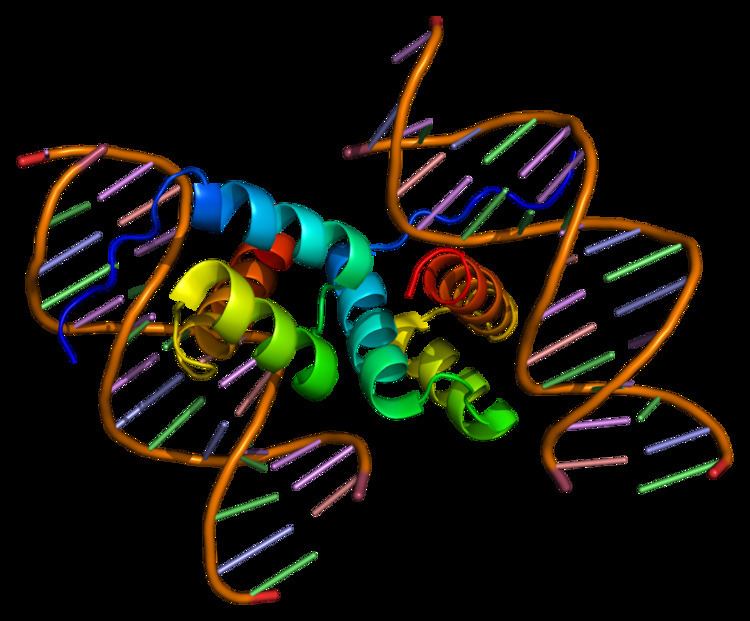Species Human Entrez 3651 | Human Mouse Ensembl ENSG00000139515 | |
 | ||
Aliases PDX1, GSF, IDX-1, IPF1, IUF1, MODY4, PAGEN1, PDX-1, STF-1, pancreatic and duodenal homeobox 1 External IDs MGI: 102851 HomoloGene: 175 GeneCards: PDX1 | ||
PDX1 (pancreatic and duodenal homeobox 1), also known as insulin promoter factor 1, is a transcription factor necessary for pancreatic development, including β-cell maturation, and duodenal differentiation. In humans this protein is encoded by the PDX1 gene, which was formerly known as IPF1.
Contents
Pancreatic development
In pancreatic development, Pdx1 is expressed by a population of cells in the posterior foregut region of the definitive endoderm, and Pdx1+ epithelial cells give rise to the developing pancreatic buds, and eventually, the whole of the pancreas—its exocrine, endocrine, and ductal cell populations. Pancreatic Pdx1+ cells first arise at mouse embryonic day 8.5-9.0 (E8.5-9.0), and Pdx1 expression continues until E12.0-E12.5, after which Pdx1 expression decreases and the pancreas is formed—other transcription factors are expressed, controlling the fates of the cells of the newly formed pancreas. Homozygous Pdx1 knockout mice form pancreatic buds but fail to develop a pancreas, and transgenic mice in which tetracycline application results in death of Pdx1+ cells are almost completely apancreatic if doxycycline (tetracycline derivative) is administered throughout the pregnancy of these transgenic mice, illustrating the necessity of Pdx1+ cells in pancreatic development.
β-cell maturation and survival
Pdx1 is also necessary for β-cell maturation: developing β-cells co-express Pdx1, NKX6-1, and insulin, a process that results in the silencing of MafB and the expression of MafA, a necessary switch in maturation of β-cells. Pdx1 appears to also play a role in the fating of endocrine cells, encoding for insulin and somatostatin, two pancreatic endocrine products, while repressing glucagon. Thus, Pdx1 expression apparently favors the production of insulin+ β-cells and somatostatin+Δ-cells rather than glucagon+ α-cells. In addition to roles in beta-cell differentiation, Pdx1 is required for β-cell survival. Cells with reduced Pdx1 have an increased rate of apoptotic programmed cell death.
Transcriptional Network
Pdx1+ pancreatic progenitor cells also co-express Hlxb9, Hnf6, Ptf1a and NKX6-1, and these progenitor cells form the initial pancreatic buds, which further proliferate and branch in response to FGF-10 signaling. Afterwards, fating of the pancreatic cells begins; a population of cells has Notch signaling inhibited, and subsequently, expresses Ngn3. This Ngn3+ population is a transient population of pancreatic endocrine progenitors that gives rise to the α, β, Δ, PP, and ε cells of the Islets of Langerhans. Other cells will give rise to the exocrine and ductal pancreatic cell populations.
Duodenum
Pdx1 is necessary for the development of the proximal duodenum and maintenance of the gastro-duodenal junction. Duodenal enterocytes, Brunner's glands and entero-endocrine cells (including those in the gastric antrum) are dependent on Pdx1 expression. It is a ParaHox gene, which together with Sox2 and Cdx2, determines the correct cellular differentiation in the proximal gut. In mature mice duodenum, several genes have been identified which are dependent on Pdx1 expression and include some affecting lipid and iron absorption.
Pathology
Mutations in the Pdx1 gene may be involved in several pancreatic pathologies, including diabetes mellitus. Maturity onset diabetes of the young (Type 4) can be caused by heterozygous mutations in Pdx1
Expression is lost in gastric cancers, suggesting a role as a tumor suppressor.
Interactions
Pdx1 has been shown to interact with MAFA.
